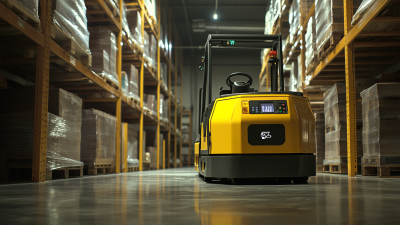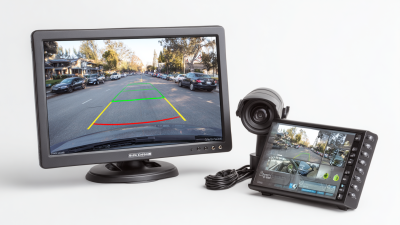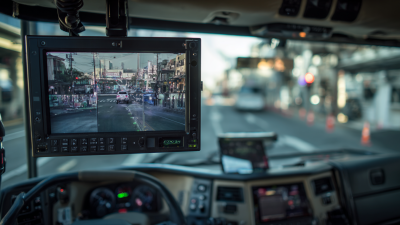Leave Your Message
In today's fast-paced industrial environments, ensuring the safety of both workers and equipment is paramount. One innovative solution that has gained traction in recent years is the Forklift Camera System. These systems provide a transformative approach to enhancing visibility around forklift operations, significantly reducing the risk of accidents and injuries. The implementation of such technology not only bolsters safety but also improves operational efficiency by allowing drivers to navigate tighter spaces with greater confidence. By integrating high-definition cameras and advanced monitoring capabilities, forklift camera systems offer real-time insights that are crucial in preventing blind spots and facilitating better decision-making on the warehouse floor. In this blog, we will explore the five key benefits of utilizing forklift camera systems, shedding light on how they can elevate safety protocols and optimize productivity in your workplace.

Forklift camera systems represent a significant advancement in material handling safety and efficiency. These integrated systems typically include rear-view cameras, side cameras, and even 360-degree views, allowing operators to gain a comprehensive understanding of their surroundings. By providing a clear visual of blind spots and potential hazards, these cameras dramatically reduce the risk of accidents in busy work environments. Operators no longer have to rely solely on mirrors or their peripheral vision, which can often be inadequate; instead, they can count on real-time video feeds to make informed decisions.
In addition to enhancing safety, forklift camera systems also contribute to operational efficiency. With increased visibility, operators can navigate tight spaces and crowded aisles with greater confidence, minimizing the likelihood of costly collisions. Furthermore, many systems come equipped with advanced features such as obstacle detection and alerts, which proactively notify drivers of potential dangers. This not only streamlines logistics but also promotes a safer workplace culture, fostering an environment where safety and productivity go hand in hand. As businesses continue to prioritize both efficiency and safety in their operations, investing in forklift camera systems becomes a pivotal choice for modern warehouse management.

 The modern warehouse environment often presents unique safety challenges, particularly concerning visibility around forklifts. According to the Occupational Safety and Health Administration (OSHA), approximately 25% of forklift accidents occur due to limited visibility. Forklift camera systems significantly enhance visibility by providing drivers with a 360-degree view of their surroundings, effectively reducing blind spots. By integrating these advanced camera systems, companies can create a safer working environment, leading to a reduction in accidents and injuries.
The modern warehouse environment often presents unique safety challenges, particularly concerning visibility around forklifts. According to the Occupational Safety and Health Administration (OSHA), approximately 25% of forklift accidents occur due to limited visibility. Forklift camera systems significantly enhance visibility by providing drivers with a 360-degree view of their surroundings, effectively reducing blind spots. By integrating these advanced camera systems, companies can create a safer working environment, leading to a reduction in accidents and injuries.
A study by the National Institute for Occupational Safety and Health (NIOSH) indicates that equipping forklifts with camera systems can decrease blind-spot-related incidents by an impressive 30%. This improvement not only enhances the safety of operators and pedestrians but also contributes to overall operational efficiency. With clearer visibility, forklift operators can navigate complex environments confidently, making safer and more timely decisions. As safety measures are prioritized, the potential for costly downtime due to accidents diminishes, showcasing the dual benefits of improved visibility and operational efficiency in warehouse operations.
Real-time monitoring has become a cornerstone for improving operator awareness in various industries, particularly when it comes to enhancing safety in environments that involve heavy machinery. Forklift camera systems exemplify this trend, providing operators with a clear view of their surroundings and minimizing blind spots. By integrating these visual aids into daily operations, businesses can significantly reduce the likelihood of accidents and injuries, safeguarding their workforce.
Recent advancements in technology underscored the importance of proactive monitoring systems. Companies are leveraging data analytics and AI-driven solutions to anticipate potential hazards before they escalate. These innovations not only enable immediate responses to unsafe conditions but also ensure that operators remain aware of their environment in real-time. The deployment of such systems, akin to those adopted in offshore and mining operations, reflects a growing commitment to maintaining high safety standards across industries, proving that enhanced operator awareness is critical for both safety and efficiency in the workplace.
| Benefit | Description | Impact on Safety | Impact on Efficiency |
|---|---|---|---|
| Improved Operator Awareness | Real-time video feeds enable operators to have a clear view of their surroundings, reducing blind spots. | Higher situational awareness leads to proactive safety measures. | Enhances precision in maneuvering, minimizing accidents during operations. |
| Reduction of Accidents | Camera systems help prevent collisions by providing visual feedback. | Significantly lowers the rate of workplace injuries. | Less downtime due to accidents increases overall productivity. |
| Enhanced Training | Camera footage can be used as a training tool for new operators. | Improves safety awareness among new operators by learning from real scenarios. | Faster training processes lead to quicker workforce readiness. |
| Remote Monitoring | Supervisors can monitor operations remotely for safety compliance. | Increased oversight helps prevent unsafe behavior. | Operations can be streamlined by identifying inefficiencies in real-time. |
| Data Analysis | Video data can be analyzed to improve operational procedures. | Identifies recurring safety issues to address proactively. | Informed decisions based on data can optimize workflow and reduce delays. |
In today’s fast-paced industrial environments, optimizing productivity is a top priority. Forklift camera systems offer a game-changing solution that enhances not only safety but also efficiency. By providing operators with greater visibility and situational awareness, these technologies reduce blind spots, making operations smoother and more streamlined.
One significant benefit of forklift camera technology is its ability to minimize accidents, ultimately leading to increased productivity. When operators can see more clearly, they can navigate more confidently, thus reducing downtime caused by collisions or mishaps. To maximize these efficiency gains, companies should consider integrating dual-camera systems that offer both front and rear views, allowing operators to make quick and informed decisions without leaving the cabin.
Furthermore, implementing training programs that teach workers how to utilize these camera systems effectively can greatly enhance their potential. Regularly reviewing camera footage can also serve as a valuable training tool, helping operators refine their skills and decision-making processes. Emphasizing the importance of camera utilization not only boosts productivity but fosters a safety-first culture within the workplace.
Implementing forklift camera systems in warehouses not only enhances safety but also proves to be a cost-effective solution in the long run. Investing in these advanced camera systems reduces accidents and injuries, which can lead to significant financial savings. The costs associated with workplace injuries—medical expenses, worker compensation, and loss of productivity—can quickly add up. By utilizing camera systems, warehouses can minimize these risks, resulting in fewer incidents and lower insurance premiums, ultimately contributing to substantial long-term savings.
Additionally, forklift camera systems improve operational efficiency, which further enhances their cost-effectiveness. By providing operators with a clearer view of their surroundings, these systems help in reducing the time taken for loading and unloading goods. This translates to higher throughput and better utilization of resources. Furthermore, as the technology becomes more integrated into everyday operations, training costs for new employees may decrease, as the improved visibility aids in quicker acclimatization to the warehouse environment. Hence, the initial investment in forklift camera systems can yield impressive returns, underscoring their value in both safety and financial metrics.






